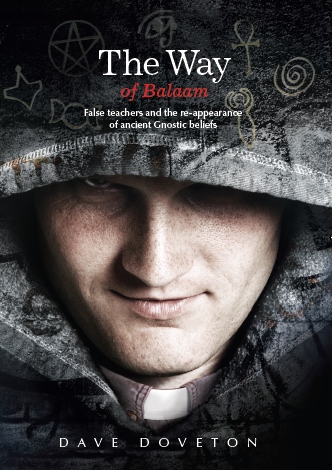 Book Review by Lawrie Wilmot
Book Review by Lawrie Wilmot
THE WAY OF BALAAM: FALSE TEACHERS AND THE REAPPEARANCE OF ANCIENT GNOSTIC BELIEFS by Dave Doveton
My review presumes that the reader has both Biblical and theological knowledge: I therefore do not go into overly lengthy explanations of some of the terms in this review. Although I know Dave personally as a brother minister and friend, I will refer to him in the third person throughout the article.
This book is not a light theological read, and neither is it’s message to be taken lightly. The author’s aim is to prove, as he states, that ‘the Gnostic temptation is at the root of every Christian error and heresy.’ The book gives a comprehensive survey of the origins, definition and doctrines of Gnosticism, and explains why it’s modern manifestations are so toxic to the Church. It is a thoroughly researched and extensively referenced work, and the literary style is concise, clear and readable. In my review I give a summary of the main teaching in the book.
So who was Balaam, and why does the author link him with Gnosticism?
Balaam’s story
Balaam’s story is set out in Numbers Chapters 22-24. He unfortunately compromised his prophetic ministry; Balaam was greedy for wealth, and, as his story in Numbers shows, went beyond what the Lord was telling him to do by persisting in searching for something in addition to God’s Word. He began to put his own interests above those of God’s people, and in the end was deceived. Like most propagators of false teaching, he did not appear as overtly bad, but he seduced the Israelites into indulging in immorality and in the worship of Baal Peor. He came to personify false religion in Scripture.
Balaam is mentioned twice in the New Testament: Jude warns us how such ungodly people creep in unnoticed and subtly spread the virus of their false teaching, infecting many. Balaam did not learn from his encounter with the angel, and as he was judged, so will they be.
Secret knowledge
So what exactly is Gnosticism? The word is derived from the Greek word ‘gnosis’, meaning ‘knowledge.’ The Gnostics basically believed that secret knowledge, or gnosis, was the key to salvation. Anyone who possessed that key was ‘enlightened’ and spiritually superior to everyone else, especially orthodox Christians.
Gnostic beliefs, and their doctrine, were errant from the start. First of all, their view of the Bible was that it was just a record of peoples’ lives, and that it could not be taken literally. Ps. 119vs. 105 reads: ‘ The sum of thy word is truth’ and Jesus said ‘ I am the way, the truth and the life.” ~ John 14v.6. Gnostic belief, on the other hand, was that truth was within the individual, was therefore subjective, and could only be gained by inner insight: therefore no external teaching authority was considered necessary for the Gnostic believer. Their doctrine was deliberately irrational in that it shunned the methods of rational and scientific thought. It bypassed the rational mind to achieve ‘enlightenment’, this process being described as ‘the journey of the soul.’
‘If it feels good, do it’
Their view of man was that our human identity is discovered within ourselves; that the individual is supreme and has absolute autonomy; and that human experience was to be the basis for decision-making and behaviour. ( We see this today in the popular belief ‘ If it feels good, do it.” Nothing new under the sun!)
The Gnostics also believed that matter was evil. To them the human soul was captive in a material existence and gaining self-knowledge was of supreme importance as the way of escaping from its bondage.
They denied original sin and therefore the need of a saviour. Modern Gnostic belief reduces our Lord Jesus to a ‘saviour figure’, not the Saviour. Their doctrine of ‘salvation’ was consequently a counterfeit of orthodox doctrine: ‘repentance’ became turning inward to face the soul, to liberate it from ignorance, doubt and fear. This led to one becoming ‘an enlightened one”, i.e. saved from these things and being led upward ‘to connection with the divine.’ Gnostic doctrine is monistic: this theology holds that all is one, and that the creation is part of the Creator, in the same way that a spider spins his web out of his own bodily substance. Animism is practised: it is seen in the personification of creation, amongst other practices.( I once saw a banner in a church proclaiming, “ Treasure Mother Earth.” Modern-day Gnostic thought is definitely with us.)
The author gives many theological insights on Gnosticism. Those of vital importance to the Church are, inter alia, (and I will be mainly quoting from the book), that it is nothing less than one of Satan’s weapons to defeat Christianity.
Pagan world order is aim
The author points out that the devil’s aim, via Gnosticism and the pagan beliefs and practices it incorporates, is to establish a pagan world order. This starts with corrupting the leadership of government and the church and undermining the judicial system. This can happen when the agreed standard of truth, objectively based on Christian values, is removed and replaced by truth based on subjective standards and values. (Does this seem far-fetched? New Age and similar belief systems are propagating things like ‘your truth and my truth’; “situational ethics”; and ‘relativistic”moral standards.)
As the author points out, all this begins when humanity ‘exchanges the truth about God for a lie’~ Romans 1v.25f., and the downward spiral into idolatry and ‘all manner of unrighteous behaviour” begins. No less a writer than Alexander Solzhenitsyn believes that the elimination of a transcendent God in so many secular ideological systems and the consequent belief in the autonomy of human beings is the root cause of the decline of the West.
Like borer beetle infestation
With the collapse of a Christian moral foundation to society the rule of law and the independence of the judicial system is compromised. The author compares this process to borer beetle infesting a wooden structure: from the outside it looks solid, but if one leans on it, it gives way. This will happen to the Church if the corruptive influence of pagan-Gnostic thought and practice is not removed.
The author goes on to paint a bleak picture of the eventual state of society: in his penultimate chapter entitled ‘ The Coming Chaos’ he systematically sets out how such chaos could become a reality in the not too distant future.
So what must we, as the Church, do?
Fortunately this is something that was successfully done in past centuries to counter and defeat Gnosticism and its manifestations. Gnosticism, as the author points out, died out in the Church during the 3rd century, thanks to the faithfulness of the early bishops and teachers who, even though it often entailed persecution and sometimes martyrdom, proclaimed the true faith and taught orthodox doctrine. The Canon of Scripture was set by the end of the 4th century, defining the limits of apostolic teaching.
Mandate to uphold truth
That is our mandate as well: to consistently uphold the ‘faith once for all delivered to the saints’, to teach sound doctrine, and to counter false teaching.
The author quotes a 4th century apologist, Santantius, who advised his fellow Christians on how to react to opposition: “Do not meet violence with violence; carry on speaking the truth; don’t be intimidated into silence; engage your opponents in debate; rely on the Holy Spirit; teach logically.’ History is also on our side: it records that anything opposing God’s order and truth will eventually die.
Our biggest challenge today is not to compromise our beliefs and practice; we must always bear in mind that a compromised Church is an impotent Church. Bishop Bill Burnett once warned that “If the Church is not evangelising the world, the world will be evangelising the Church.”
I hope that this review will have convinced you of the danger of present-day Gnostic thought and practice and its ramifications.
I believe that this book should be prescribed reading for every Christian leader: it’s message is contemporary, eloquently argued, and compelling. It has also been written in such a way as to be accessible to any lay Christian in search of the truth.
Where to buy the book: The Way of Balaam can be bought at any “Christian Book Discounters” shop, or ordered
direct from the author : davedoveton@gmail.com. In PE it can be bought from St. Saviour’s Church bookshop, cr. Villiers Rd and 1st Ave Walmer. Check shopping hours by phoning Mary MacGregor on 041 581 7788. Price R120.








A very timely book. The deception has spread so widely in many of our churches already.